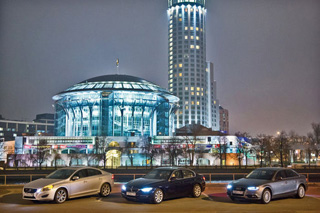Test drive BMW 3 Episode F30 since 2012 sedan
Russian "treshka"
If on a new three -year -old BMW there is a nameplate 318i, do not believe your eyes: she has a new two -liter motor under the hood. Yes, and it was collected not in Bavaria, but in Mother Russia.In the appearance of the BMW of the third series of 2001 and 2002 model years, the difference, by and large, is small. The head of the head optics and the hood are slightly corrected, the indicators of the turns are hidden over the transparent glass, the radiator grate nostrils are expanded. The profile and food changed even less (stamping appeared on the side, crowned on the front wing with a turn repeater, and the feed received several other lights and the rear bumper).
Nevertheless, the car began to look even more dynamic. 16-inch wheels also work for this. They are collected on steel disks (cast - option), but equipped with pleasant -looking caps.
The car’s interior remained the same. Torpedo is primarily aimed at the driver. The corporate slogan with pleasure driving is again confirmed by reality.
In the workplace, it is equally convenient for a person of any complexion. The only thing that, as before, can be complained, is some visual clamp.
The back is quite spacious, however, planting and landing is less pleasant than on the front seats: the toe of the boot strives to catch on the middle rack.
This car is primarily interested in the new two -liter engine, and the hood that has risen on gas springs opens a rather unusual sight. Firstly, the engine is almost all in the base - for the front axle, ten centimeters protrudes. Secondly, the block itself is not vertically, but at an angle of degrees twenty, and even shifted relative to the central axis of the car to the right in the direction of movement.
On the left mudguard, we note the autotor plate indicating that the machine is assembled in Kaliningrad. How does this threaten the consumer? Nothing, except that the price of a car is about 20% lower than that of the same, collected in Germany. For example, our car will cost the consumer 29,900 euros, and not ours - 37000. Moreover, the assembly quality of autor's BMW is better than German, which were more than once confirmed by the inspectors from Munich.
At idle speeds, as expected, the engine is practically not heard (BMW has always been distinguished by magnificent sound insulation) and is not visible - it does not run the slightest trembling on the body. Remember the block tilted by twenty degrees? Due to this, it was possible to significantly reduce vibration from the work of the motor.
Even before the test, we noted that an automatic gearbox was installed on the car. Frankly, at first it had somewhat arranged us - it seemed that the engine could not fully realize its capabilities with an automaton.
But we, as it turned out, were mistaken. The five-speed STEPTRONIC does not in any way cool the ardor of the 143-horsepower engine. Transfigurations in normal mode are gently, quickly, and most importantly, adequately. It looks even better when the automatic selector is transferred to Sport. It is then that the true triumph of new technologies begins.
Equipped with the Valvetronic revolutionary system, which made it possible to abandon the throttle, the power unit gives out the maximum torque in two hundred newtonometers at three and a half thousand revolutions. Previously, the engine almost similar in volume (only 100 cubes) could squeeze out only 180 nm at 3900 min-1. This motor also responds much faster to spur.
The newcomer is also equipped with a Doppel-Vanos system, which is a separate adjustment of the gas distribution phase for intake and exhaust valves. Thanks to it, the maximum torque is held in a wide range of revolutions.
The advantages are as follows. Firstly, a constant supply of traction. At whatever speed the car goes on, it is worth squeezing the gas pedal a little, and the threek immediately shoots. This is especially nice on the highway at the time of overtaking. And the start from the place brings much more adrenaline to the blood than before. To achieve the notorious 100 km/h, now only 10 seconds are needed. The maximum speed increased: it is 214 km/h - eight more than the previous result.
Of course, the work of new systems affects fuel efficiency. Despite the fact that the sensor showing the instantaneous fuel consumption was almost always in our right position, the average consumption did not exceed 8 liters. By the way, BMW, made in Kaliningrad, can consume gasoline with an octane number of at least 91, while German - 95 and above.
To focus on how the car behaves and how pleasant emotions the driver experiences, we think there is no need. As before, this is an exceptionally light and competent car in the management of a car, sitting into which, you regret that the trip will not be endless ...
Text: Oleg Kalaushin
Source: Magazine 5 wheel








